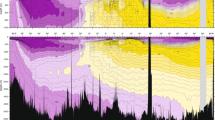Abstract
Recent developments in moored oceanographic sampling devices and in satellite techniques have led to a realization of the inadequacies of past descriptions of the sea which, due to limitations in technology, placed a heavy reliance on coarse-scale measurements and the assumption of a steady-state ocean. The increasing interest in Gulf Stream Rings and long period coastal trapped wave phenomena with several-day periods (e.g. Smith, 1978) are just two illustrations of the increased recognition of the need for better definitions of the ocean’s temporal and spatial variability. Over the last 15 years or so, chemical and biological oceanographers have attempted to redress the problem of inadequate sampling densities by continuous mapping of temperature, salinity, nutrients and chlorophyll a at the sea-surface (e.g. Packard, in press; Schink et al. in press), by using vertically lowered shipboard pumping systems to better resolve high vertical gradients in chemical and biochemical properties (e.g. Anderson, 1982) and by a heavier reliance on satellite information and other optical techniques (Yentsch and Yentsch, 1984). Attempts to develop moored devices for sampling chemical and biological variables have, however, tended to lag behind development of modern high resolution instruments for measuring physical variables.
Access this chapter
Tax calculation will be finalised at checkout
Purchases are for personal use only
Preview
Unable to display preview. Download preview PDF.
Similar content being viewed by others
References
Anderson, J.J. 1982. The nitrite-oxygen interface at the top of the oxygen minimum zone in the eastern tropical North Pacific. Deep-Sea Res. 29: 1193–1201.
Blakar, I.A. 1979. A close-interval water sampler with minimal disturbance properties. Limnol. Oceanogr. 24: 983–988.
Broenkow, W.W. 1969. An interface sampler using spring-activated syringes. Limnol. Oceanogr. 14: 288–291.
Clasby, R.C., W.S. Reeburgh and V. Alexander. 1972. A close-interval syringe sampler. Limnol. Oceanogr. 17: 632–633.
Cline, J.D., H.B. Milburn and D.P. Wisegarver. 1982. A simple rosette-mounted syringe sampler for the collection of dissolved gases. Deep-Sea Res. 29: 1245–1250.
Codispoti, L.A. 1981. Temporal nutrient variability in three different upwelling regions. In: Coastal Upwelling. F.A. Richards (ed.), Am. Geophys. Union, Washington, D.C. 529 pp.
Friederich, G.E. and L.A. Codispoti. 1981. The effects of mixing and regeneration on the nutrient content of the upwelling waters off Peru. In: Coastal Upwelling. F.A. Richards (ed.), Am. Geophys. Union, Washington, D.C. 529 pp.
Hargrave, B.T. and G.F. Connolly. 1978. A device to collect supernatant water for measurement of the flux of dissolved compounds across sediment surfaces. Limnol. Oceanogr. 23: 1005–1010.
Packard, T.T. In press. The use of enzyme analysis to measure and map oxygen consumption in the ocean. In: Chemical Oceanography: Analytics of Mesoscale and Macroscale Processes. A. Zirino (ed.); Advances in Chemistry Series No. 208, American Chemical Society, Washington, D.C.
Schink, D.R., P.J. Setser, S.T. Sweet, and N.L. Guinasso, Jr. In press. Sampling the upper 100 m of a warm core ring with a towed pumping system. In: Chemical Oceanography: Analytics of Mesoscale and Macroscale Processes. A. Zirino (ed.); ADVANCES IN CHEMISTRY SERIES No. 208, American Chemical Society, Washington, D.C.
Sholkovitz, E.R. 1970. A free vehicle bottom-water sampler. Limnol. Oceanogr. 15: 641–644.
Smith, R.L. 1978. Poleward propagating perturbations in currents and sea level along the Peru coast. J. Geophys. Res. 83: 6083–6092.
Whitledge, T.E., S.C. Malloy, C.J. Patton and C.D. Wirick. 1981. Automated Nutrient Analyses in Seawater. Brookhaven National Lab. report #51398. Upton, NY. 216 pp.
Yentsch, C.M. and C.S. Yentsch. 1984. Emergence of optical instrumentation for measuring biological properties. Oceanogr. Mar. Biol. Ann. Rev. 22: 55–98.
Author information
Authors and Affiliations
Editor information
Editors and Affiliations
Rights and permissions
Copyright information
© 1986 Springer-Verlag Berlin Heidelberg
About this chapter
Cite this chapter
Friederich, G.E., Kelly, P.J., Codispoti, L.A. (1986). An Inexpensive Moored Water Sampler for Investigating Chemical Variability. In: Bowman, M.J., Yentsch, C.M., Peterson, W.T. (eds) Tidal Mixing and Plankton Dynamics. Lecture Notes on Coastal and Estuarine Studies, vol 17. Springer, New York, NY. https://doi.org/10.1007/978-1-4612-4966-5_19
Download citation
DOI: https://doi.org/10.1007/978-1-4612-4966-5_19
Publisher Name: Springer, New York, NY
Print ISBN: 978-0-387-96346-4
Online ISBN: 978-1-4612-4966-5
eBook Packages: Springer Book Archive




